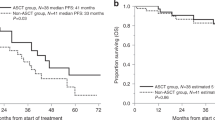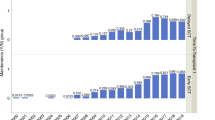Abstract
Randomized trials showing that high-dose therapy with autologous stem cell transplant (ASCT) improved the overall survival (OS) in multiple myeloma (MM) excluded patients over age 65. To compare the outcomes of older adults with MM who underwent ASCT with non-transplant strategies, we identified 146 patients aged 65–77 with newly diagnosed MM seen in the Washington University School of Medicine from 2000 to 2010. Survival among patients who did (N=62) versus did not (N=84) undergo ASCT was compared using Cox proportional hazards modeling, controlling for comorbidities, Eastern Cooperative Oncology Group performance status (PS) and the propensity to undergo ASCT. Median age was 68 years (range 65–77). PS and comorbidities did not differ significantly between those who did versus those who did not undergo ASCT. Median OS was significantly longer in patients who underwent ASCT than in those who did not (median 56.0 months (95% confidence intervals (CIs) 49.1–65.4) versus 33.1 months (24.3–43.1), P=0.004). Adjusting for PS, comorbidities, Durie–Salmon stage and the propensity to undergo ASCT, ASCT was associated with superior OS (HR for mortality 0.52 (95% CI 0.30–0.91), P=0.02). In a cohort of older adults with MM, undergoing ASCT was associated with a nearly 50% lower mortality, after controlling for PS, comorbidities, stage and the propensity to undergo ASCT.
This is a preview of subscription content, access via your institution
Access options
Subscribe to this journal
Receive 12 print issues and online access
$259.00 per year
only $21.58 per issue
Buy this article
- Purchase on Springer Link
- Instant access to full article PDF
Prices may be subject to local taxes which are calculated during checkout




Similar content being viewed by others
References
Smith BD, Smith GL, Hurria A, Hortobagyi GN, Buchholz TA . Future of cancer incidence in the United States: burdens upon an aging, changing nation. J Clin Oncol 2009; 27: 2758–2765.
Pulte D, Gondos A, Brenner H . Improvement in survival of older adults with multiple myeloma: results of an updated period analysis of SEER data. Oncologist 2011; 16: 1600–1603.
Kumar SK, Dispenzieri A, Lacy MQ, Gertz MA, Buadi FK, Pandey S et al. Continued improvement in survival in multiple myeloma: changes in early mortality and outcomes in older patients. Leukemia 2014; 28: 1122–1128.
Kyle RA, Gertz MA, Witzig TE, Lust JA, Lacy MQ, Dispenzieri A et al. Review of 1027 patients with newly diagnosed multiple myeloma. Mayo Clin Proc 2003; 78: 21–33.
Klepin HD, Hurd DD . Autologous transplantation in elderly patients with multiple myeloma: are we asking the right questions? Bone Marrow Transplant 2006; 38: 585–592.
Attal M, Harousseau JL, Stoppa AM, Sotto JJ, Fuzibet JG, Rossi JF et al. A prospective, randomized trial of autologous bone marrow transplantation and chemotherapy in multiple myeloma. Intergroupe Français du Myélome. N Engl J Med 1996; 335: 91–97.
Child JA, Morgan GJ, Davies FE, Owen RG, Bell SE, Hawkins K et al. High-dose chemotherapy with hematopoietic stem-cell rescue for multiple myeloma. N Engl J Med 2003; 348: 1875–1883.
Roncon S, Barbosa IL, Campilho F, Lopes SM, Campos A, Carvalhais A . Mobilization and collection of peripheral blood stem cells in multiple myeloma patients older than 65 years. Transplant Proc 2011; 43: 244–246.
Cheikh ElJ, Kfoury E, Calmels B, Lemarie C, Stoppa A-M, Bouabdallah R et al. Age at transplantation and outcome after autologous stem cell transplantation in elderly patients with multiple myeloma. Hematol Oncol Stem Cell Ther 2011; 4: 30–36.
Bashir Q, Shah N, Parmar S, Wei W, Rondon G, Weber DM et al. Feasibility of autologous hematopoietic stem cell transplant in patients aged≥ 70 years with multiple myeloma. Leuk Lymphoma 2012; 53: 118–122.
Muta T, Miyamoto T, Fujisaki T, Ohno Y, Kamimura T, Kato K et al. Evaluation of the feasibility and efficacy of autologous stem cell transplantation in elderly patients with multiple myeloma. Intern Med 2013; 52: 63–70.
Piccirillo JF, Creech CM, Zequeira R, Anderson S, Johnston AS . Inclusion of comorbidity into oncology data registries. J Registry Manage 1999; 26: 66–70.
Oken MM, Creech RH, Tormey DC, Horton J, Davis TE, McFadden ET et al. Toxicity and response criteria of the Eastern Cooperative Oncology Group. Am J Clin Oncol 1982; 5: 649–655.
Launay-Vacher V, Chatelut E, Lichtman SM, Wildiers H, Steer C, Aapro M et al. Renal insufficiency in elderly cancer patients: International Society of Geriatric Oncology clinical practice recommendations. Ann Oncol 2007; 18: 1314–1321.
Durie BG, Salmon SE . A clinical staging system for multiple myeloma. Correlation of measured myeloma cell mass with presenting clinical features, response to treatment, and survival. Cancer 1975; 36: 842–854.
Greipp PR . International Staging System for Multiple Myeloma. J Clin Oncol 2005; 23: 3412–3420.
Little R, Rubin DB . Statistical Analysis with Missing Data. J. Wiley & Sons: New York, NY, USA, 1987.
Rosenbaum P, Rubin D . The central role of the propensity score in observational studies for causal effects. Biometrika 1983; 70: 41–55.
Liu J, Weinhandl ED, Gilbertson DT, Collins AJ St, Peter WL . Issues regarding “immortal time” in the analysis of the treatment effects in observational studies. Kidney Int 2012; 81: 341–350.
Boyko EJ . Observational research — opportunities and limitations. J Diabetes Complications 2013; 27: 642–648.
Merz M, Neben K, Raab MS, Sauer S, Egerer G, Hundemer M et al. Autologous stem cell transplantation for elderly patients with newly diagnosed multiple myeloma in the era of novel agents. Ann Oncol 2014; 25: 189–195.
Kumar SK, Dingli D, Lacy MQ, Dispenzieri A, Hayman SR, Buadi FK et al. Autologous stem cell transplantation in patients of 70 years and older with multiple myeloma: results from a matched pair analysis. Am J Hematol 2008; 83: 614–617.
Gertz MA, Lacy MQ, Dispenzieri A, Hayman SR, Kumar S, Leung N et al. Impact of age and serum creatinine value on outcome after autologous blood stem cell transplantation for patients with multiple myeloma. Bone Marrow Transplant 2007; 39: 605–611.
Krejci M, Buchler T, Hajek R, Svobodnik A, Krivanova A, Pour L et al. Autologous bone marrow transplantation in multiple myeloma: a single centre experience of 23 patients. Bone Marrow Transplant 2005; 35: 159–164.
Lenhoff S, Hjorth M, Westin J, Brinch L, Backstrom B, Carlson K et al. Impact of age on survival after intensive therapy for multiple myeloma: a population-based study by the Nordic Myeloma Study Group. Br J Haematol 2006; 133: 389–396.
Facon T, Mary JY, Hulin C, Benboubker L, Attal M, Pegourie B et al. Melphalan and prednisone plus thalidomide versus melphalan and prednisone alone or reduced-intensity autologous stem cell transplantation in elderly patients with multiple myeloma (IFM 99–06): a randomised trial. Lancet 2007; 370: 1209–1218.
Palumbo A, Bringhen S, Bruno B, Falcone AP, Liberati AM, Grasso M et al. Melphalan 200mg/m(2) versus melphalan 100mg/m(2) in newly diagnosed myeloma patients: a prospective, multicenter phase 3 study. Blood 2010; 115: 1873–1879.
Ozaki S, Harada T, Saitoh T, Shimazaki C, Itagaki M, Asaoku H et al. Survival of multiple myeloma patients aged 65-70 years in the era of novel agents and autologous stem cell transplantation. A multicenter retrospective collaborative study of the Japanese Society of Myeloma and the European Myeloma Network. Acta Haematol 2014; 132: 211–219.
Katz S, Ford AB, Moskowitz R, Jackson B, Jaffe M . Studies of Illness in the Aged: The Index of ADL. JAMA 1963; 185: 914–919.
Lawton M, Brody E . Assessment of older people: self-maintaining and instrumental activities of daily living. Gerontologist 1969; 9: 179–986.
Hurria A, Togawa K, Mohile SG, Owusu C, Klepin HD, Gross CP et al. Predicting Chemotherapy Toxicity in Older Adults With Cancer: a prospective multicenter study. J Clin Oncol 2011; 29: 3457–3465.
Extermann M, Boler I, Reich RR, Lyman GH, Brown RH, DeFelice J et al. Predicting the risk of chemotherapy toxicity in older patients: the Chemotherapy Risk Assessment Scale for High-Age Patients (CRASH) score. Cancer 2012; 118: 3377–3386.
Bringhen S, Mateos M-V, Zweegman S, Larocca A, Falcone AP, Oriol A et al. Age and organ damage correlate with poor survival in myeloma patients: meta-analysis of 1435 individual patient data from 4 randomized trials. Haematologica 2013; 98: 980–987.
Kleber M, Ihorst G, Terhorst M, Koch B, Deschler B, Wäsch R et al. Comorbidity as a prognostic variable in multiple myeloma: comparative evaluation of common comorbidity scores and use of a novel MM–comorbidity score. Blood Cancer J 2011; 1: e35–e38.
Kleber M, Ihorst G, Groß B, Koch B, Reinhardt H, Wäsch R et al. Validation of the Freiburg Comorbidity Index in 466 multiple myeloma patients and combination with the international staging system are highly predictive for outcome. Clin Lymphoma Myeloma Leuk 2013; 13: 541–551.
Jantunen E, Kuittinen T, Penttilä K, Lehtonen P, Mahlamäki E, Nousiainen T . High-dose melphalan (200mg/m2) supported by autologous stem cell transplantation is safe and effective in elderly (⩾65 years) myeloma patients: comparison with younger patients treated on the same protocol. Bone Marrow Transplant 2006; 37: 917–922.
Terpos E, Apperley JF, Samson D, Giles C, Crawley C, Kanfer E et al. Autologous stem cell transplantation in multiple myeloma: improved survival in nonsecretory multiple myeloma but lack of influence of age, status at transplant, previous treatment and conditioning regimen. A single-centre experience in 127 patients. Bone Marrow Transplant 2003; 31: 163–170.
Reece DE, Bredeson C, Pérez WS, Jagannath S, Zhang M-J, Ballen KK et al. Autologous stem cell transplantation in multiple myeloma patients /=60 years of age. Bone Marrow Transplant 2003; 32: 1135–1143.
O'Shea D, Giles C, Terpos E, Perz J, Politou M, Sana V et al. Predictive factors for survival in myeloma patients who undergo autologous stem cell transplantation: a single-centre experience in 211 patients. Bone Marrow Transplant 2006; 37: 731–737.
Offidani M, Leoni P, Corvatta L, Polloni C, Gentili S, Savini A et al. ThaDD plus high dose therapy and autologous stem cell transplantation does not appear superior to ThaDD plus maintenance in elderly patients with de novo multiple myeloma. Eur J Haematol 2010; 84: 474–483.
Acknowledgements
This publication was made possible by the Grant nos KM1CA156708 and K12CA167540 through the National Cancer Institute (NCI) at the National Institutes of Health (NIH) and Grant nos UL1 TR000448 through the Clinical and Translational Science Award (CTSA) program of the National Center for Advancing Translational Sciences (NCATS) at the National Institutes of Health. We acknowledge the support of the Biostatistics Core, Siteman Comprehensive Cancer Center and NCI Cancer Center Support Grant P30 CA091842.
Author information
Authors and Affiliations
Corresponding author
Ethics declarations
Competing interests
The authors declare no conflict of interest.
Rights and permissions
About this article
Cite this article
Wildes, T., Finney, J., Fiala, M. et al. High-dose therapy and autologous stem cell transplant in older adults with multiple myeloma. Bone Marrow Transplant 50, 1075–1082 (2015). https://doi.org/10.1038/bmt.2015.106
Received:
Revised:
Accepted:
Published:
Issue Date:
DOI: https://doi.org/10.1038/bmt.2015.106
This article is cited by
-
Treatment benefit of upfront autologous stem cell transplantation for newly diagnosed multiple myeloma: a systematic review and meta-analysis
BMC Cancer (2023)
-
Clinical significance of high-dose chemotherapy with autologous stem cell transplantation in the era of novel agents in patients older than 65 years with multiple myeloma
Annals of Hematology (2023)
-
Outcomes with autologous stem cell transplant vs. non-transplant therapy in patients 70 years and older with multiple myeloma
Bone Marrow Transplantation (2021)
-
Real-life data on safety and efficacy of autologous stem cell transplantation in elderly patients with multiple myeloma
Annals of Hematology (2019)
-
Updates on Hematologic Malignancies in the Older Adult: Focus on Acute Myeloid Leukemia, Chronic Lymphocytic Leukemia, and Multiple Myeloma
Current Oncology Reports (2019)



